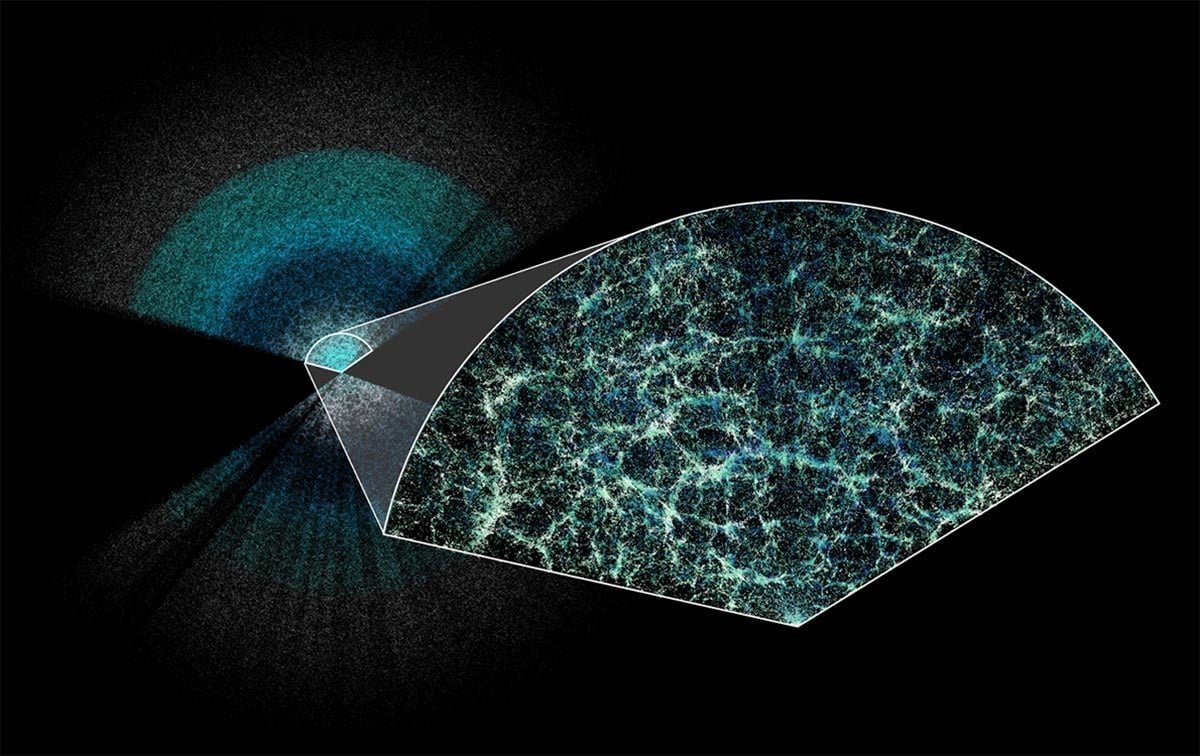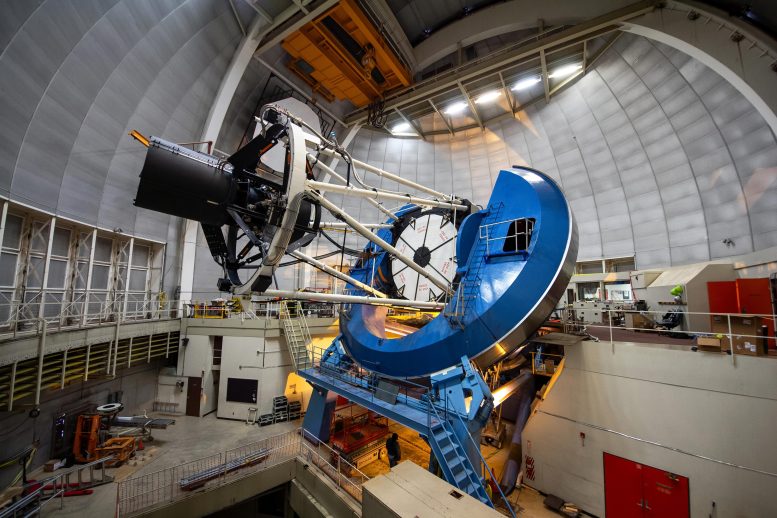
Unraveling Dark Energy and Cosmic Expansion With an 11-Ton Time Machine
-
by Anoop Singh
- 30

DESI has made the largest 3D map of our universe to date. Earth is at the center of this thin slice of the full map. In the magnified section, it is easy to see the underlying structure of matter in our universe. Credit: Claire Lamman/DESI collaboration; custom colormap package by cmastro
The Dark Energy Spectroscopic Instrument (DESI), mounted on a telescope in Arizona, has created the largest 3-D map of the cosmos, mapping over 30 million galaxies and 3 million quasars. This monumental task, a collaboration of over 900 researchers, helps us understand the universe’s expansion and the role of dark energy.
We now have the largest 3D map of our cosmos ever created, thanks to a powerful instrument mounted atop a telescope in Arizona with a robotic array of 5,000 fiber-optic “eyes” that look into the night sky. Over the last five years, the Dark Energy Spectroscopic Instrument—known in science circles as DESI—has measured the spectra of more than 30 million galaxies and 3 million quasars to determine how fast the universe expanded over 11 billion years.
DESI’s announcement is the result of an ongoing international collaboration comprising more than 900 researchers from over 70 institutions, including astronomers at UC Santa Cruz with leadership roles in the project.
And yet, as big as this news is, they say it’s just the beginning.

The Dark Energy Spectroscopic Instrument (DESI) is mounted on the U.S. National Science Foundation Nicholas U. Mayall 4-meter Telescope at Kitt Peak National Observatory. Credit: KPNO/NOIRLab/NSF/AURA/P. Marenfeld
Pioneering Discoveries and Future Visions
“If the trends hinted here in this first-year dataset are confirmed in our Year Three analysis, this will be a major discovery,” said cosmologist Alexie Leauthaud, associate professor in UC Santa Cruz’s Astronomy and Astrophysics Department. “This is going to be a tremendously exciting time to be part of the DESI collaboration.”
Starting in July, Leauthaud will serve as a spokesperson for the effort—which entails lead-organizer duties—so she is perfectly positioned to provide updates. Other collaborating professors at UC Santa Cruz include Connie Rockosi and J. Xavier Prochaska, also in Astronomy & Astrophysics.
Rockosi led the commissioning of the instrument at the 4-meter Mayall telescope at Kitt Peak National Observatory, and her present role is as an instrument scientist, helping to keep it running in top shape. In addition, the professors credit “a phenomenal team” of UC Santa Cruz undergrads, grad students, and postdocs who have been deeply engaged with the project—visiting the telescope in Arizona on a regular basis to help with observations.
Unraveling the Mysteries of Dark Energy
As explained in an announcement from Lawrence Berkeley National Laboratory, where DESI is based: “Understanding how our universe has evolved is tied to how it ends, and to one of the biggest mysteries in physics: dark energy, the unknown ingredient causing our universe to expand faster and faster.”
This is the first time scientists have measured the expansion history of the young universe with a precision better than 1%—giving us our best view yet of how the universe evolved. Researchers shared the analysis of their first year of collected data in multiple papers that will be posted today on the arXiv and in talks at the American Physical Society meeting in the United States and the Rencontres de Moriond in Italy.
In this 360-degree video, take an interactive flight through millions of galaxies mapped using coordinate data from DESI. Credit: Fiske Planetarium, CU Boulder and DESI collaboration
Sven Heydenreich, a postdoctoral research scholar at UC Santa Cruz, wears multiple hats at DESI: serving on a commission for early-career scientists, performing galaxy-to-galaxy measurements with the instrument, and co-leading a working group that forecasts different scenarios for a potential continuation of the DESI mission.
“The goal is to measure how DESI galaxies bend and distort the light from more distant galaxies located behind them, an effect known as gravitational lensing,” said Heydenreich, who spent a week on site at Kitt Peak at the end of 2023. “These measurements will be essential for analyzing how galaxies are influenced by the distribution of dark matter surrounding them. Moreover, the results will help improve our understanding of the parameters that describe our current model of the universe’s composition and evolution.”
An 11-Ton Time Machine
DESI’s components are designed to automatically point at preselected sets of galaxies, gather their light, and then split that light into narrow bands of color to precisely map their distance from Earth and gauge how much the universe expanded as this light traveled to Earth. In ideal conditions, DESI can cycle through a new set of 5,000 galaxies every 20 minutes.
By repeatedly mapping the distance to the many millions of galaxies and quasars across one-third of the area of the sky over the past five years, DESI is teaching us more about dark energy and the history of the universe. Our present understanding is that gravity slowed the rate of expansion in the early universe, but dark energy has since accelerated its expansion.
DESI’s overall precision on the expansion history across all 11 billion years is 0.5%, and the most distant epoch—covering 8-11 billion years in the past—has a record-setting precision of 0.82%. That measurement of our young universe is incredibly difficult to make. Yet within one year, DESI has become twice as powerful at measuring the expansion history at these early times as its predecessor (the Sloan Digital Sky Survey’s BOSS/eBOSS), which took more than a decade.
Looking at DESI’s map, it’s easy to see the underlying structure of the universe: strands of galaxies clustered together, separated by voids with fewer objects. Our very early universe, well beyond DESI’s view, was quite different: a hot, dense soup of subatomic particles moving too fast to form stable matter like the atoms we know today. Among those particles were hydrogen and helium nuclei, collectively called baryons.
Tiny fluctuations in this early ionized plasma caused pressure waves, moving the baryons into a pattern of ripples that is similar to what you’d see if you tossed a handful of gravel into a pond. As the universe expanded and cooled, neutral atoms formed and the pressure waves stopped, freezing the ripples in three dimensions and increasing clustering of future galaxies in the dense areas. Billions of years later, we can still see this faint pattern of 3-D ripples, or bubbles, in the characteristic separation of galaxies—a feature called Baryon Acoustic Oscillations (BAOs).
This animation shows how baryon acoustic oscillations act as a cosmic ruler for measuring the expansion of the universe. Credit: Claire Lamman/DESI collaboration and Jenny Nuss/Berkeley Lab
Researchers use the BAO measurements as a cosmic ruler. By measuring the apparent size of these bubbles, they can determine distances to the matter responsible for this extremely faint pattern on the sky. Mapping the BAO bubbles both near and far lets researchers slice the data into chunks, measuring how fast the universe was expanding at each time in its past and modeling how dark energy affects that expansion.
“We’ve measured the expansion history over this huge range of cosmic time with a precision that surpasses all of the previous BAO surveys combined,” said Hee-Jong Seo, a professor at Ohio University and the co-leader of DESI’s BAO analysis. “We’re very excited to learn how these new measurements will improve and alter our understanding of the cosmos. Humans have a timeless fascination with our universe, wanting to know both what it is made of and what will happen to it.”
For more on these results, see Dark Energy Revealed Through Largest 3D Map of the Universe Ever Made.
DESI is supported by the DOE Office of Science and by the National Energy Research Scientific Computing Center, a DOE Office of Science user facility. Additional support for DESI is provided by the U.S. National Science Foundation; the Science and Technology Facilities Council of the United Kingdom; the Gordon and Betty Moore Foundation; the Heising-Simons Foundation; the French Alternative Energies and Atomic Energy Commission (CEA); the National Council of Humanities, Sciences, and Technologies of Mexico; the Ministry of Science and Innovation of Spain; and by the DESI member institutions.
The DESI collaboration is honored to be permitted to conduct scientific research on Iolkam Du’ag (Kitt Peak), a mountain with particular significance to the Tohono O’odham Nation.
DESI has made the largest 3D map of our universe to date. Earth is at the center of this thin slice of the full map. In the magnified section, it is easy to see the underlying structure of matter in our universe. Credit: Claire Lamman/DESI collaboration; custom colormap package by cmastro The Dark Energy Spectroscopic…
DESI has made the largest 3D map of our universe to date. Earth is at the center of this thin slice of the full map. In the magnified section, it is easy to see the underlying structure of matter in our universe. Credit: Claire Lamman/DESI collaboration; custom colormap package by cmastro The Dark Energy Spectroscopic…
